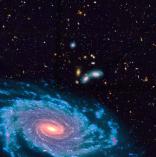Highlights 2008
An international team of astronomers lead by scientists of the Astrophysics Division of CEA-IRFU has discovered large molecular gas reservoirs - the combustible for forming new stars - hosted in ordinary massive galaxies in the young, distant Universe. The discovery has been made with the IRAM Plateau de Bure Interferometer located in the French Alps, observing at millimeter wavelengths. This finding indicates that massive galaxies built major fractions of their stars in a nearly continuous way, and not on very rapid bursts as thought before, and open new major possibilities for understanding galaxy formation at high redshifts. The results are published in the January 2008 issue of the Astrophysical Journal.
Image credits: MPIA Heidelberg (Hi_res 1.7Mo / Med_res 0.4Mo)
Surprisingly, an asymmetry in the distribution of antimatter in the central regions of our Galaxy has just been discovered. By adding all scientific data acquired since five years by the spectrometer SPI aboard the INTEGRAL satellite, a European research group, including scientists from the Service d'Astrophysique at CEA-IRFU , has observed a gamma-ray photon emission of an energy of 511 keV, which is characteristic for the annihilation of electrons and their antimatter particles, the positrons. The researchers could determine the morphology of the 511 keV emission in the central regions of our Galactic disk, which reveals to be asymmetric and very similar to the distribution of a certain type of X-ray binary sources. For some time already these objects are thought to be efficient factories for positron production, and could explain the origin of these antimatter particles in the central regions of our Galactic disk. This work has been published in the scientific journal Nature on January 10th, 2008.


